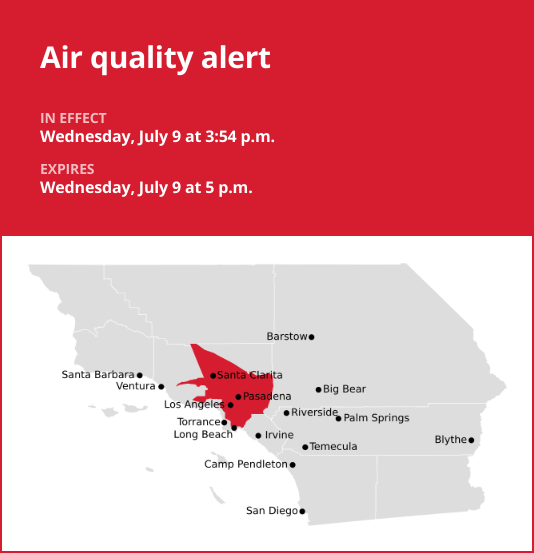Los Angeles County is the focus of an updated air quality alert reported at 3:54 p.m. on Wednesday by the National Weather Service. The alert is in effect until 5 p.m.
“The South Coast AQMD has updated an air quality alert due to harmful levels of ozone pollution,” can be anticipated according to the NWS Los Angeles/Oxnard CA. “To help keep indoor air clean when air quality is poor: 00 * Keep windows and doors closed * Run your air conditioner and/or an air purifier * Do not use whole house fans or swamp coolers that bring in outside air if you have other methods to stay cool * Avoid other sources of pollution such as fireplaces, candles, incense, and grilling To help minimize outdoor ozone air pollution levels: * Limit the use of gasoline powered lawn and garden equipment until evening hours * Try to delay trips to the 00gas station and the use of household chemicals until the evening.”
“Ozone air pollution can cause serious health problems, including trouble breathing, asthma attacks, and lung damage. Everyone can be affected, but sensitive groups such as people with lung disease, older adults, people who are pregnant, children, and those who spend a lot of time outdoors are at greater risk,” the NWS said.
The full list of affected locations includes:
- Santa Clarita Valley
- Los Angeles County Inland Coast including Downtown Los Angeles
- Calabasas/Agoura Hills
- San Fernando Valley
- Santa Susana Mountains
- 5 Freeway corridor near Santa Clarita
- Western San Gabriel Mountains/Highway 14 Corridor
- Eastern San Gabriel Mountains
- San Gabriel Valley

Air quality alerts: Recommendations from the NWS
When an air quality alert pops up on the radar, deciphering its implications is crucial. These alerts, issued by the NWS, come with straightforward yet essential guidance to ensure your safety:
Seek shelter indoors when possible:
If possible, remain indoors, especially if you have respiratory issues, other health concerns, or fall within the senior or child demographics.
Trim outdoor activities to essentials:
When you can’t avoid going outdoors, keep outdoor activities to the bare essentials. Reducing your time outdoors is the key.
Cut back on pollution-inducing activities:
Be mindful of activities that increase pollution, like driving cars, operating gas-powered lawnmowers, or using motorized vehicles. Limit their usage during air quality alerts.
A no to open burning:
Avoid burning debris or any other materials during air quality alerts. This contributes to worsened air quality.
Stay well-informed:
Keep yourself well-informed by tuning in to NOAA Weather Radio or your preferred weather news outlet. Staying in the loop empowers you to make informed decisions regarding outdoor engagements during air quality alerts.
Focus on respiratory health:
If you have respiratory issues or health problems, exercise extra caution. These conditions can make you more vulnerable to the adverse effects of poor air quality.
By adhering to the recommendations from the NWS, you can enhance your safety during air quality alerts and reduce your exposure to potentially harmful pollutants. Stay vigilant, stay protected, and prioritize your health above all else.